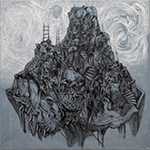What happens to a home once it is left behind?
Does it remain in stone and silence—or does it migrate too, transforming itself into song, into memory?
In Imaginary Homeland, memory defines architecture. Through layered drawings on denim and linen—materials marked by wear, labor, and tenderness—the artist reimagines the homes of childhood countries that have been abandoned or transformed. Inspired by the historic structures of Aleppo, Syria, these works are not merely reconstructions of place, but emblems of what endures: the warmth of a kitchen, the curved flow of an old-fashioned cursive, the comfort of a lullaby passed down.
Some pieces draw from the mythic: a saint who once lived atop a column near Aleppo, considered mad in life and saintly in death. His pillar became a site of
pilgrimage. People broke off pieces of it to eat, believing it would bring fertility. Here, the sacred and the absurd meld into a symbol of endurance, ritual, and
faith.
In contrast, a series of 24 small color paintings offers an intimate reflection on our relationship with the land—planting, harvesting, and the quiet dialogue between soil and hand. These works honor the cycles of the harvest, showing how the earth inspires us, and how, in turn, we help it to bloom.
Two major installations extend the exhibition’s terrain: one honoring migrants who crossed the Mediterranean Sea in search of safety, and another meditating on the birth of language and culture—fragile beginnings from which entire worlds grow.
As the artist has often contended, “Art holds a responsibility to document time—so that future generations may understand what it meant to live, to dream, and to endure in the moment of its making.”
Together, these works ask: What do we carry when we are forced to leave? What is buried, what is remembered, and what—through memory and care—might still take root?
Press release from Galerie Tanit
Image: Kevork Mourad. The Labyrinth and the Stairs. 2025. Acrylic on Denim Fabric. 122 x 122 cm. Image courtesy of the artist and Galerie Tanit



